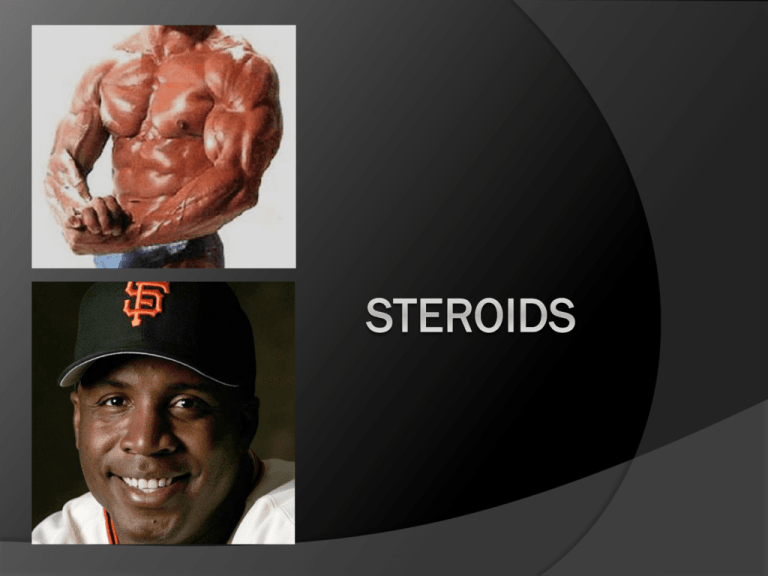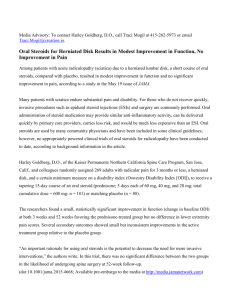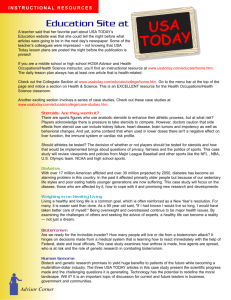Steroids - myronlowery
advertisement

What are steroids? Anabolic androgenic steroids are synthetic derivatives of the male hormone testosterone that are taken to build muscle, enhance performance, and improve appearance help the body retain protein Slang terms for steroids Gym Candy Pumpers/Stackers Weight Trainers Rhoids Juice Who uses steroids? The majority of steroid users tend to be young, male athletes Adolescents may use them to quicken the onset of puberty and maturation, male and female models may take them to improve their body image. Those in certain, physically demanding occupations, like law enforcement, bouncers, or military personnel How are steroids used? Taken orally in tablet form or injected intramuscularly Users rely on hearsay and gossip to determine dosage levels that may not be safe How are steroids used (Cont’d)? Individuals abusing steroids take megadoses of hundreds of milligrams per day, whereas doctors prescribe only 1 to 5 mg. per day for legitimate medical uses Users often take steroids in “cycles” where they use steroids for six to 12 weeks at a time punctuated by periods where they do not take steroids. Steroid users do this to avoid building up a tolerance. Steroids and other drugs Steroid users may combine steroids with stimulants, depressants, pain killers, anti-inflammatory drugs, and other hormones to offset steroid side effects Where to get them… The majority of steroids are illegally manufactured or traded on the black market which eliminates any quality controls. Steroids may be contaminated, mislabeled, or bogus. Doctors prescription Legal steroids Used medically for some forms of anemia, some breast cancers, osteoporosis, endometriosis, and hereditary angiodema (a swelling disorder) Doctors prescribe a small, controlled amount to the patient Signs someone is on steroids Rapid weight gain and muscle development Acne flare up Fluid retention Jaundice (yellow tinge to eyes and skin) Mood swings and depressed moods Aggressive behavior Premature balding Side Effects Enlargement of the heart high blood pressure heart attack permanently damage the liver Causes cancer, jaundice, bleeding, and hepatitis. Steroids can impair the kidneys leading to kidney stones and kidney disease. Guys v. Gals Men experience prostate enlargement, sterility, sexual dysfunction, baldness, breast enlargement, and testicular atrophy. excess testosterone is converted to the female hormone estrogen which causes the development of female characteristics Guys v. Gals Excess testosterone in females has the opposite effect, causing menstrual irregularities, deepening of the voice, baldness, fetal damage, hair growth on other parts of the body, sexual dysfunction, sterility, reduction of breasts, and genital swelling. Why try Rhoids? feel peer pressure overly concerned with their body image believe their competition uses steroids they don’t believe that steroids are dangerous to use Treatment/Help Contact your local Drug and Alcohol Abuse Commission hotline Recommend alternatives (legal protein and vitamin supplements) Seek medical attention ASAP Legal Consequences Because of negative side effects and the potential for abuse, anabolic androgenic steroids have been classified as controlled substances with severe penalties for trafficking, possession, or use. Most athletic associations, including the International Olympic Committee, test athletes for steroids, and penalize those in whom steroids are detected. What are they? There are four main types of inhalants: Volatile solvents Gases Aerosols Nitrites Volatile solvents liquids that become a gas at room temperature Some examples are: paint thinners and removers Gasoline Glues felt-tip marker fluids Gases Medical gases ether, nitrous oxide Household or commercial products butane lighters, propane tanks, whipped cream dispensers that contain nitrous oxide, and refrigerants Aerosols Some of the most prevalent inhalants in the home They include: spray paint, deodorant and hairsprays, vegetable oil cooking sprays, and static cling sprays. Nitrites Include cyclohexyl nitrite, amyl nitrite, and butyl nitrite. On the street, they're called "poppers" or "snappers." They're found in some room deodorizers and capsules that release vapors when opened. How people take Inhalants People inhale chemical vapors in several ways, including: sniffing, snorting, or spraying the inhalant directly into the nose or mouth putting it into a bag or other container and then inhaling from there putting the vapor onto a rag or inhaling nitrous oxide from balloons. Side Note: Because the high from inhalants only lasts a few minutes, some people may inhale over and over again for long periods of time to maintain the high, increasing the amount of dangerous chemicals entering and damaging the body. Effects on the body Once the vapors enter the body, some are absorbed by parts of the brain and nervous system. All of the inhalants (except nitrites) slow down the body's functions, similar to the effects of drinking alcohol can sometimes take up to 2 weeks for the chemical to completely pass from the body A- Normal Brain B- Brain after 2 months of inhalant use Short term effects increased heart rate hallucinations or delusions losing feeling or consciousness nausea and vomiting loss of coordination slurred speech Long term effects brain damage (toxic chemicals may make people become slow or clumsy, have trouble solving problems or planning ahead, suffer from memory loss, or become unable to learn new things) muscle weakness depression headaches and nosebleeds loss of sense of smell or hearing How inhalants kill "Sudden Sniffing Death" — This is the most common cause of death from inhalant use. The heart beats quickly and irregularly, and then suddenly stops (cardiac arrest). This can happen even the first time a person tries an inhalant and is experimenting. Signs of inhalant use mood swings extreme anger, agitation, and irritability exhaustion loss of appetite frequent vomiting hallucinations and illusions facial rashes and blisters frequent runny nose and cough dilated pupils glazed or watery eyes extremely bad breath Getting help talk to your doctor, school counselor, or nurse the two main categories of treatment are: behavioral helping a person change behaviors pharmacological treating a person with medication


